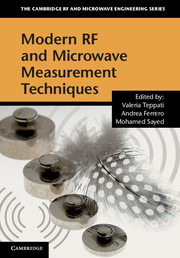Book contents
- Frontmatter
- Contents
- Preface
- List of contributors
- List of abbreviations
- Part I General concepts
- Part II Microwave instrumentation
- Part III Linear measurements
- 8 Two-port network analyzer calibration
- 9 Multiport and differential S-parameter measurements
- 10 Noise figure characterization
- 11 TDR-based S-parameters
- Part IV Nonlinear measurements
- Index
- References
11 - TDR-based S-parameters
from Part III - Linear measurements
Published online by Cambridge University Press: 05 June 2013
- Frontmatter
- Contents
- Preface
- List of contributors
- List of abbreviations
- Part I General concepts
- Part II Microwave instrumentation
- Part III Linear measurements
- 8 Two-port network analyzer calibration
- 9 Multiport and differential S-parameter measurements
- 10 Noise figure characterization
- 11 TDR-based S-parameters
- Part IV Nonlinear measurements
- Index
- References
Summary
Introduction
Many engineers are familiar with the VNA as an instrument for measuring S-parameters. The VNA's origins lie in microwave systems analysis and its application has been primarily in the frequency domain. Many are also familiar with the use of TDR for making qualitative measurements of time domain reflections and other phenomena. TDR has its origins in signal integrity analysis, as signal integrity is primarily concerned with time domain effects.
It is less well known that TDR and associated TDT is also a highly useful technique for precise quantitative measurements in signal integrity and can be used effectively for S-parameter measurement.
This chapter deals with the measurement of S-parameters using time domain techniques such as found in TDR and TDT. We cover the topic by first describing the hardware architecture of TDR instruments including the sampling system, the pulser, and the timebase. Then we describe how time domain TDR and TDT measurements are converted to raw, uncalibrated, frequency domain S-parameters. We do not deal with calibration techniques as these are the same for the VNA and TDR once raw S-parameters have been determined. Then, we quantitatively discuss the main element that effects the accuracy of time domain measurements: that of noise or SNR. SNR is such a big problem that it is the major source of error in time domain derived S-parameters and it is worthwhile understanding the sources of dynamic range degradation in TDR systems and the key design areas for improvement.
Information
- Type
- Chapter
- Information
- Modern RF and Microwave Measurement Techniques , pp. 279 - 306Publisher: Cambridge University PressPrint publication year: 2013
References
Accessibility standard: Unknown
Why this information is here
This section outlines the accessibility features of this content - including support for screen readers, full keyboard navigation and high-contrast display options. This may not be relevant for you.Accessibility Information
- 2
- Cited by
